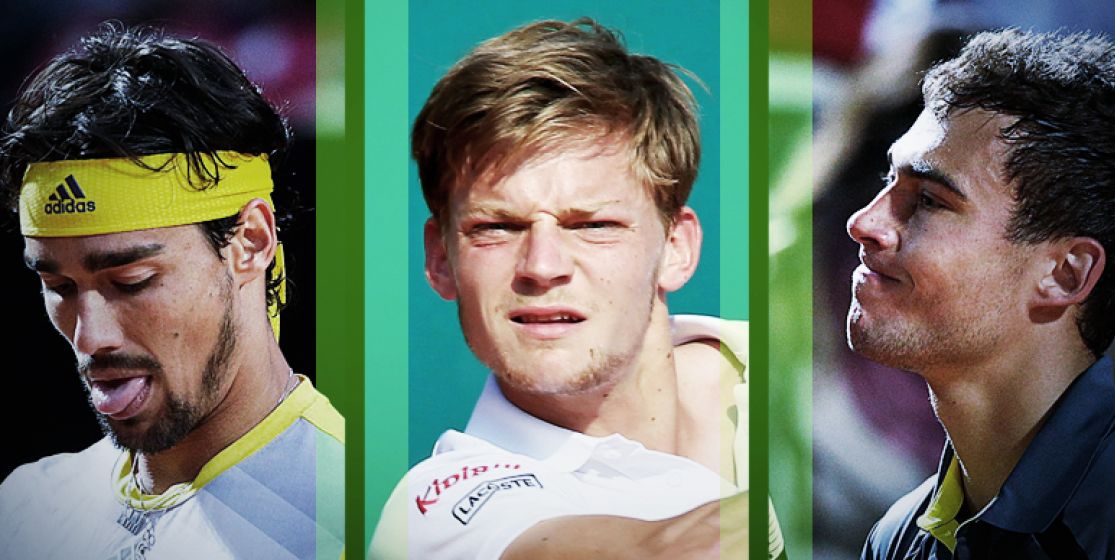The public of the Porte d'Auteuil is not just a polite crowd applauding between points and performing "Ola" during change of sides. Roland Garros, as long as you know where to look, is also a kaleidoscopic circus of screams, flags and beer cups. Here are the best “ones to watch” in the draw. One thing is certain: if you want to attend their games, take a seat at the previous match, as you won’t be alone!
Boring Belgium, great fun
No need to go far to find the most festive crowd at Roland Garros: they speak French, always smile, mainly feed on chips and cool off with beer... Welcome to Belgium! "For us, Roland Garros is the most important tournament, the one with the greatest visibility and therefore where we want to get noticed the most" said Filip Dewulf, whose surprise semi-final in 1997, after battling through the qualifiers, raised an unprecedented momentum. Since then, the popularity has never wavered in Belgium – a relationship of cause and effect? It was in Paris that players from the kingdom have shone the brightest: Kim Clijsters with her two finals (2001 and 2003), Xavier Malisse and Olivier Rochus with their doubles title (2004), and, of course, Justine Hénin; winner of the junior tournament in 1997 and dominant in the women's singles, winning in 2003, 2005, 2006 and 2007. The most recent strokes of brilliance were as recent as twelve months ago: the junior title of Kimmer Coppejans and the surprise third round appearance of the lucky loser David Goffin. Lukasz Kubot, his opponent can confirm that he went mad after hearing songs such as "David! David! David "or" We're home". Uproars and teasing on the Court 7 which turned it into a gladiatorial arena.
The South Americans in general, the Argentinians in particular
Marcelo Rios first - and the "Chi Chi Chi ... Le-Le-Le ... Viva Chile" echoing in waves across the Central - Gustavo Kuerten then, and finally the Argentine wave of Coria, Gaudio, Nalbandian... for fifteen years, the South Americans have become accustomed to turning the stand of Roland Garros into annexes of their football stadiums: supporters songs, flags and faces painted in the national colours. If the phenomenon has lost its magnitude due to the gradual disappearance of the stars from Latin America - the withdrawal of Juan Martin del Potro this year will not help - the Argentine contingent always guarantees a good time on the courts during first week. For the full experience, choose the heroes of the quarter-final won against France last April in Buenos Aires, Horacio Zeballos, Carlos Berlocq and Juan Monaco. On the menu: guttural groans and t-shirts stained with sweat and dirt.
Fabio Fognini, l’arte et la commedia
All Italians are not equal: a game between Paolo Lorenzi and Potito Starace never unleashed passions at Roland Garros. But other heirs of Panatta attract their share of flag-waving supporters. First, Fabio Fognini, current world number 29 and a recent semi-finalist in Monte Carlo - where already the Transalpine were out in large numbers to cheer loudly in the hushed corridors of the Monte-Carlo Country Club. He has some notable scalps to his credit here in Paris: an unforgettable victory over Gael Monfils in 2010, 9-7 in the fifth set, and an equally Homeric success over Albert Montanes in the second round the following year, won 11-9, despite cramps leaving him unable to run in the latter stages of the match, the groans, the pleas to the heavens... and the repeated foot faults. The audience at the Suzanne Lenglen didn't know which Madonna to turn to: sincere tiredness or pure commedia dell'arte? Unable to determine with certainty, half of the court warmly applauded Italian, while the other half booed him mercilessly. And "Fogna" looking sorry, shrugged as he greeted the audience. In the same "beautifully-talented-but-a-little-amateurish" vein is his compatriot Simone Bolelli.
Benoît Paire, sweet, gifted and mad
Of course, there are Jo-Wilfried Tsonga and Gael Monfils to count on, ensuring full houses on each court they play but, for those looking to experience the local fervour, there is also the newcomer Benoit Paire. Long gone is the time when the player left the Court No. 17 during the French tennis championships, to a chorus of boos from the public, after picking up three penalty points in the last game in the under-18s final. Today, Paire has – in general - learned to control his nerves, and has one of the most attractive games of the tour: both rich, aesthetic... and inimitable. Last year, against Spain's Albert Ramos, Paire, still a little rough around the edges, managed to turn the Court 2 into a furnace. Since then, the lad has progressed well, and has just played a convincing semi-final in Rome. His popularity, already seen in training these last few days, is just waiting to explode into the open in this tournament...
How many times, Jerzy Janowicz?
He also has a strange brain. He also displays a greedy love for drop shots. But for him, it will be the first appearance in the main draw at Roland Garros, six months after his final in Bercy. The thundering Pole, with his explosive tennis and eccentric character, has become a phenomenon in his country. A certain communion was born between him and his audience, notably during a weekend of Davis Cup by BNP Paribas action against Slovenia, of which he was the hero; a weekend where he finished, microphone in hand, leading a chorus with his fans of his "How many times?" outburst at the Australian Open. Provided that the Polish fans make the trip to Roland Garros, there are no doubts that the matches of "Crazy Jerzy" will undoubtedly be spicy.
By Guillaume Willecoq






